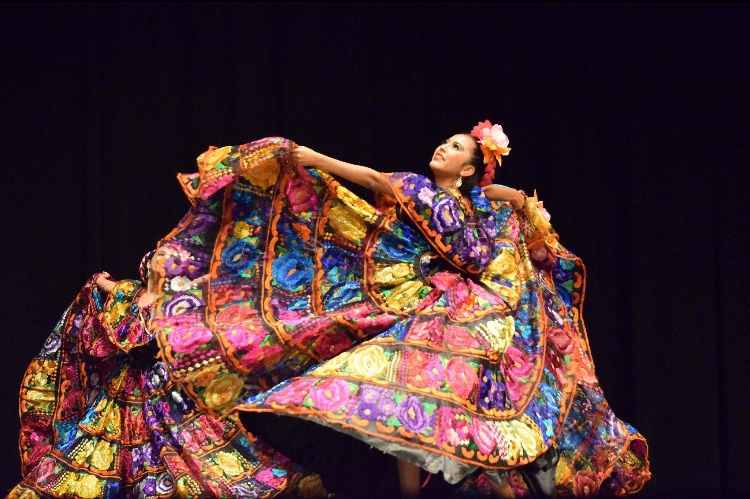
Junior Hernández performs a routine from the Mexican state of Chiapas. The movements are slow and timid, with elegant gestures meant to show off the dress.
Hernández dances into maturity through folkloric ballet
For junior Alina Hernández, dancing is a rite of passage. At the age of eight, Hernández was introduced to baile folclórico by her mother, who also started dancing at a similar age. Baile folclórico, or folkloric ballet, is a traditional Mexican dance best known for its ballet-like characteristics and emphasis for local folk culture.
“Each region of Mexico has their [own] style of dance and dress, so we learn different techniques and [dress accordingly] for each,” Hernández said.
Stepping foot on the stage is an out of body experience, according to Hernández. This is due to the overwhelming pressure to execute the performance flawlessly.
“When I get on stage, I feel a rush, but a good rush,” Hernández said. “The adrenaline is so fast, I don’t feel present sometimes, [and it] makes me feel like I’m flying.
In spite of their love of the art and cultural tie, the competitive nature of the sport created a toxic environment that led to Hernández and her mother going on hiatus. Her instructor from her former dance team was harsh towards both dancers and parents.
“My mom had enough, and we left to find a new professional group,” Hernández said.
Due to the unexpected break, Hernández learned to appreciate the role dance had in her life and its contribution to her maturity.
“I [came] to be proud to show off my culture instead of dancing because my mom told me to,” Hernández said. “I began dancing for myself and those around me.”
The dancer also realized that in order to become a better ballerina, she needed to prioritize her well-being.
“I began [to] focus on [keeping] my body healthy, [my] technique, and mentality,” Hernández said.
Ultimately, the experience motivated her and helped her look past the harsh criticism from others.
“[My current dance group,] Sol de Fuego taught me that mistakes are okay and can help you [discover] what you need to fix yourself,” Hernández said.
Hernández does not regret having gone back to dance due to the opportunity it provided her to get in touch with her culture.
“When I’m dancing—even at practice—I feel like I have a purpose,” Hernández said. “Dancing helps remind me where I’m from, because those dances have been taught for generations.”
One of Hernández’s favorite dances is inspired by the Mexican Revolutionary War and is native to Chihuahua, Mexico. She takes inspiration from one of the original dancers, Juana Gallo, who used the dance to represent the women who sacrificed their lives fighting for their country.
“The dance has very sharp and defining movements [that resemble a soldier’s],” Hernández said. “They never smile in this dance [and are] very serious and prideful.”
Hernández hopes to use her dancing as a platform for the stories she has learned so that others may also understand its cultural significance. The ballerina also learns from the art to become a stronger person much like the individuals that came before her.